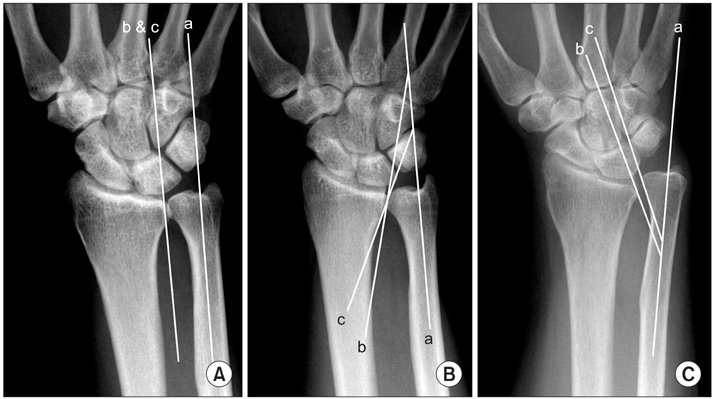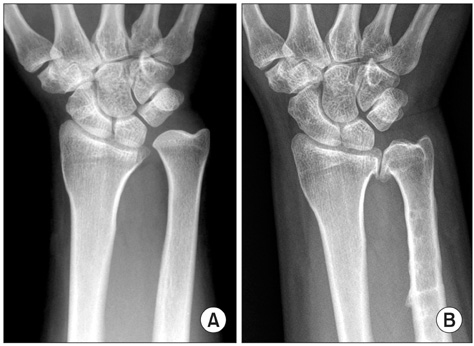Clin Orthop Surg.
2011 Dec;3(4):295-301. 10.4055/cios.2011.3.4.295.
Long-term Outcomes of Ulnar Shortening Osteotomy for Idiopathic Ulnar Impaction Syndrome: At Least 5-Years Follow-up
- Affiliations
-
- 1Department of Orthopedic Surgery, Seoul National University College of Medicine, Seoul, Korea. ghbaek@snu.ac.kr
- KMID: 1097167
- DOI: http://doi.org/10.4055/cios.2011.3.4.295
Abstract
- BACKGROUND
There have been few outcomes studies with follow-up after performing ulnar shortening osteotomy for ulnar impaction syndrome. We investigated the long-term clinical and radiological outcomes of ulnar shortening osteotomy for the treatment of idiopathic ulnar impaction syndrome.
METHODS
We retrospectively reviewed 36 patients who had undergone ulnar shortening osteotomy for idiopathic ulnar impaction syndrome for a mean follow-up of 79.1 months (range, 62 to 132 months). The modified Gartland and Werley scores were measured pre- and postoperatively. The radiographic parameters for the assessment of the distal radioulnar joint (DRUJ) as well as the relationship between these radiographic parameters and the clinical and radiological outcomes were determined.
RESULTS
The average modified Gartland and Werley wrist score improved from 65.5 +/- 8.1 preoperatively to 93.4 +/- 5.8 at the last follow-up visit. The average preoperative ulnar variance of 4.7 +/- 2.0 mm was reduced to an average of -0.6 +/- 1.4 mm postoperatively. Osteoarthritic changes of the DRUJ were first seen at 34.8 +/- 11.1 months follow-up in 6 of 36 wrists (16.7%). Those who had osteoarthritic changes in the DRUJ had significantly wider preoperative ulnar variance, a longer distal radioulnar distance and a greater length of ulnar shortening, but the wrist scores of the patients who had osteoarthritic changes in the DRUJ were comparable to those who did not have osteoarthritic changes in the DRUJ.
CONCLUSIONS
The clinical outcomes are satisfactory for even more than 5 years after ulnar shortening osteotomy for treating idiopathic ulnar impaction syndrome despite the osteoarthritic changes of the DRUJ. The patients who need a larger degree of ulnar shortening may develop DRUJ arthritis.
Keyword
MeSH Terms
Figure
Cited by 3 articles
-
Updates on Ulnar Impaction Syndrome
Jihyeung Kim, Hyun Sik Gong, Goo Hyun Baek
J Korean Orthop Assoc. 2017;52(2):103-111. doi: 10.4055/jkoa.2017.52.2.103.Factors Affecting the Occurrence of Distal Radioulnar Joint Arthritis after Ulnar Shortening Osteotomy
Chol-Jin Kim, Ho-Jin Gil, Yang-Guk Chung, Seung-Han Shin, Dong-Hyun Kim, Jun-Soo Park, Hyun-Chul Choi
J Korean Soc Surg Hand. 2014;19(2):57-64. doi: 10.12790/jkssh.2014.19.2.57.Ulnar impaction syndrome: how to diagnose and treat?
Hyun Sik Seok, Jong Woong Park, Jong Woo Kang
Arch Hand Microsurg. 2022;27(2):105-118. doi: 10.12790/ahm.21.0149.
Reference
-
1. Friedman SL, Palmer AK, Short WH, Levinsohn EM, Halperin LS. The change in ulnar variance with grip. J Hand Surg Am. 1993. 18(4):713–716.
Article2. Palmer AK, Glisson RR, Werner FW. Ulnar variance determination. J Hand Surg Am. 1982. 7(4):376–379.
Article3. Baek GH, Chung MS, Lee YH, Gong HS, Lee S, Kim HH. Ulnar shortening osteotomy in idiopathic ulnar impaction syndrome. J Bone Joint Surg Am. 2005. 87(12):2649–2654.
Article4. Minami A, Kato H. Ulnar shortening for triangular fibrocartilage complex tears associated with ulnar positive variance. J Hand Surg Am. 1998. 23(5):904–908.
Article5. Chun S, Palmer AK. The ulnar impaction syndrome: follow-up of ulnar shortening osteotomy. J Hand Surg Am. 1993. 18(1):46–53.
Article6. Koppel M, Hargreaves IC, Herbert TJ. Ulnar shortening osteotomy for ulnar carpal instability and ulnar carpal impaction. J Hand Surg Br. 1997. 22(4):451–456.
Article7. Nakamura T, Takayama S, Kikuchi Y, Osada N, Ono H. Long-term results of the ulnar shortening procedure for triangular fibrocartilage complex tear. J Jpn Soc Surg Hand. 2002. 19(3):219–224.8. Sagerman SD, Zogby RG, Palmer AK, Werner FW, Fortino MD. Relative articular inclination of the distal radioulnar joint: a radiographic study. J Hand Surg Am. 1995. 20(4):597–601.
Article9. Nishiwaki M, Nakamura T, Nakao Y, Nagura T, Toyama Y. Ulnar shortening effect on distal radioulnar joint stability: a biomechanical study. J Hand Surg Am. 2005. 30(4):719–726.
Article10. Deshmukh SC, Shanahan D, Coulthard D. Distal radioulnar joint incongruity aft er shortening of the ulna. J Hand Surg Br. 2000. 25(5):434–438.11. Tolat AR, Stanley JK, Trail IA. A cadaveric study of the anatomy and stability of the distal radioulnar joint in the coronal and transverse planes. J Hand Surg Br. 1996. 21(5):587–594.
Article12. Jung JM, Baek GH, Kim JH, Lee YH, Chung MS. Changes in ulnar variance in relation to forearm rotation and grip. J Bone Joint Surg Br. 2001. 83(7):1029–1033.
Article13. Baek GH, Chung MS, Lee YH, Gong HS, Lee S, Kim HH. Ulnar shortening osteotomy in idiopathic ulnar impaction syndrome: surgical technique. J Bone Joint Surg Am. 2006. 88(Suppl 1 Pt 2):212–220.14. Coleman DA, Blair WF, Shurr D. Resection of the radial head for fracture of the radial head: long-term follow-up of seventeen cases. J Bone Joint Surg Am. 1987. 69(3):385–392.
Article15. Nakamura R, Horii E, Imaeda T, Tsunoda K, Nakao E. Distal radioulnar joint subluxation and dislocation diagnosed by standard roentgenography. Skeletal Radiol. 1995. 24(2):91–94.
Article16. Tolat AR, Sanderson PL, De Smet L, Stanley JK. The gymnast's wrist: acquired positive ulnar variance following chronic epiphyseal injury. J Hand Surg Br. 1992. 17(6):678–681.
Article17. Moermans A, Degreef I, De Smet L. Ulnar shortening osteotomy for ulnar ideopathic impaction syndrome. Scand J Plast Reconstr Surg Hand Surg. 2007. 41(6):310–314.
Article18. Miura T, Firoozbakhsh K, Cheema T, Moneim MS, Edmunds M, Meltzer S. Dynamic effects of joint-leveling procedure on pressure at the distal radioulnar joint. J Hand Surg Am. 2005. 30(4):711–718.
Article
- Full Text Links
- Actions
-
Cited
- CITED
-
- Close
- Share
- Similar articles
-
- Ulnar Shortening Osteotomy for the Treatment of Ulnar Impaction Syndrome
- Arthroscopy of the Wrist and Ulnar Shortening Osteotomy for the Treatment of the Ulnar Impaction Syndrome
- Treatment of Ulnar Impaction Syndrome using Arthroscopy and Ulnar Shortening Osteotomy
- Updates on Ulnar Impaction Syndrome
- Intraoperative Arthroscopic Findings of Ulnar Impaction Syndrome





